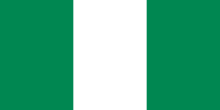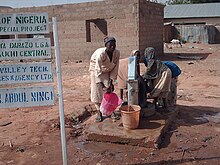This article needs to be updated. (May 2016) |
 The flag of Nigeria | |
| Data | |
|---|---|
| Water coverage (broad definition) | 67% (2015)[1] |
| Sanitation coverage (broad definition) | 33% (2015)[1] |
| Continuity of supply | not available |
| Average urban water use (L/person/day) | not available |
| Average urban water and sanitation tariff (US$/m3) | Flat residential fee of USD 3 per month in Lagos and USD 11 per month in Kaduna (2007)[2] |
| Share of household metering | 24% in Lagos, 16% in Kaduna (2007)[2] |
| Annual investment in WSS | Naira 82.5 billion (USD 0.5 billion) in 2010,[3] corresponding to US$3/capita/year |
| Share of external financing | Mainly by external donors |
| Institutions | |
| Decentralization to municipalities | No decentralization to the municipal level |
| National water and sanitation company | No |
| Water and sanitation regulator | No |
| Responsibility for policy setting | Federal Ministry of Water Resources and State Ministries of Water Resources and 36 State Water Agencies (water supply), unclear (sanitation) |
| Sector law | No |
| No. of urban service providers | 36 State Water Agencies |
| No. of rural service providers | Water and Sanitation Committees (number not available) |
Responsibility of water supply in Nigeria is shared between three (3) levels of government – federal, state and local. The federal government is in charge of water resources management; state governments have the primary responsibility for urban water supply; and local governments together with communities are responsible for rural water supply. The responsibility for sanitation is not clearly defined.[4]

Water supply service quality and cost recovery are low. Water tariffs are low and many water users do not pay their bills. Service providers thus rely mostly on occasional subsidies to cover their operating costs.[5]
National policies and Initiatives encourages the participation of private sector and reform of policy at the State level.[6] The national water supply and sanitation recognizes the importance of water supply and sanitation as it is central to healthy society and national development.[7]
- ^ a b WHO / UNICEF Joint Monitoring Programme (2015) for Water Supply and Sanitation,
- ^ a b Cite error: The named reference
AICDwas invoked but never defined (see the help page). - ^ Cite error: The named reference
Ajisegiriwas invoked but never defined (see the help page). - ^ Goldface–Irokalibe, Joe. Water Management In Federal And Federal –Type Countries: Nigerian Perspectives (PDF) (Report). pp. 14–15. Retrieved 28 May 2021.
- ^ "Addressing the social consequences of tariffs for water supply".
- ^ Cite error: The named reference
USAIDwas invoked but never defined (see the help page). - ^ Adeoti, O. (2007-02-01). "Challenges to managing water resources along the hydrological boundaries in Nigeria". Water Policy. 9 (1): 105–118. doi:10.2166/wp.2006.002. ISSN 1366-7017.
© MMXXIII Rich X Search. We shall prevail. All rights reserved. Rich X Search
